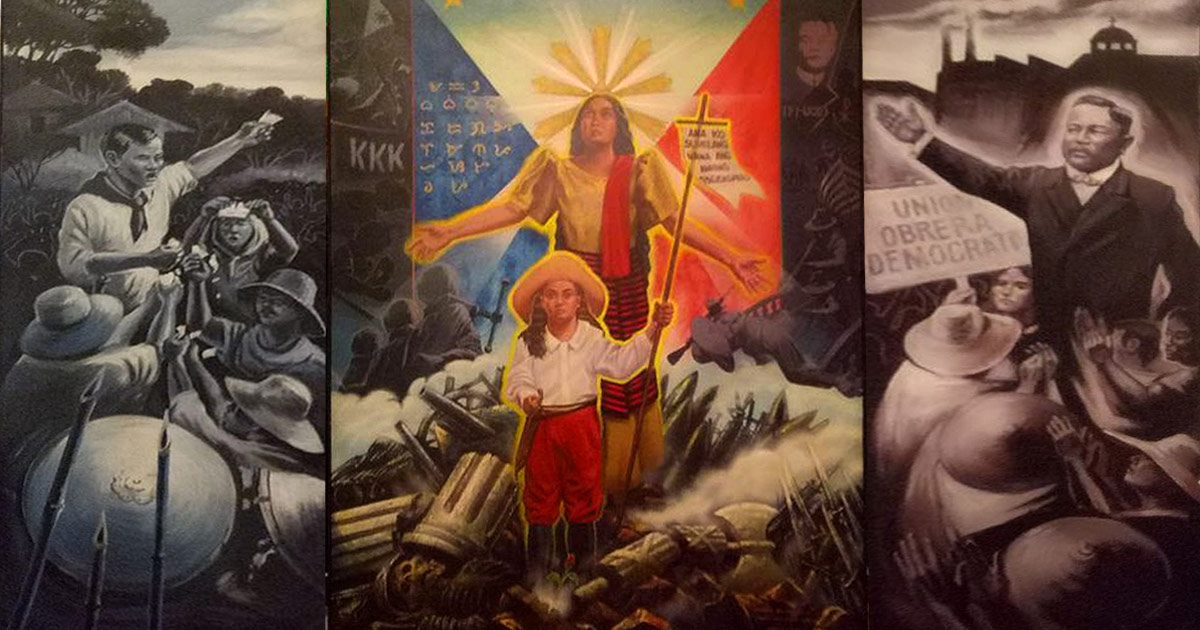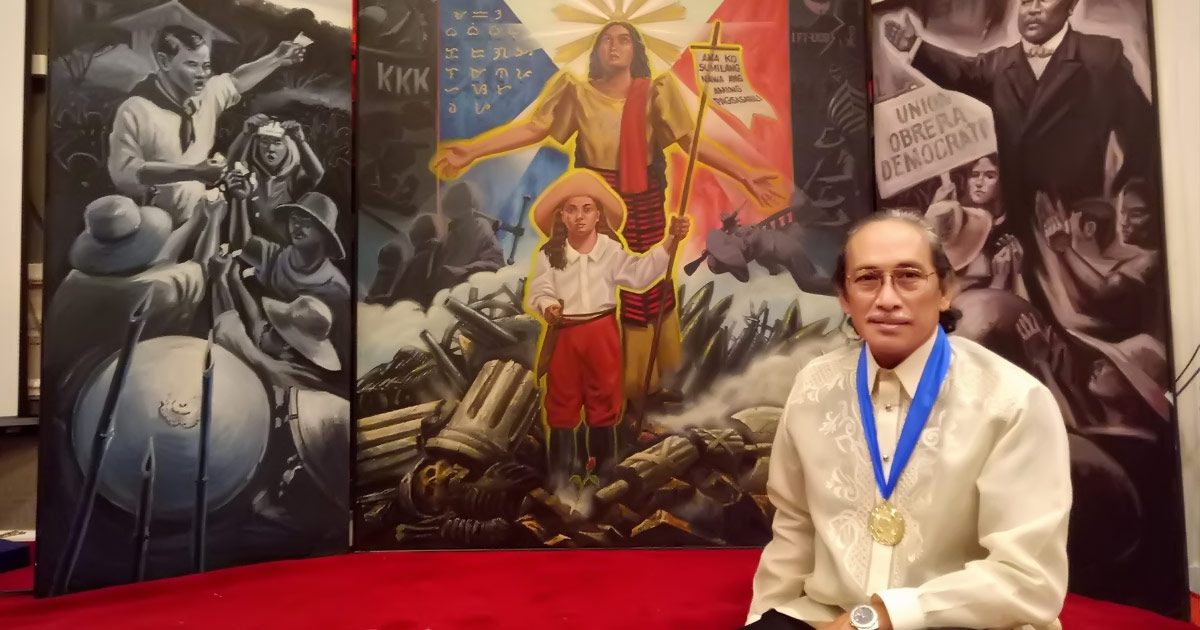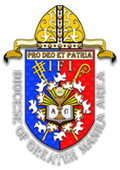Reinvigorating the Devotion
of the Birhen Balintawak
 On August 26, 2020, the Iglesia Filipina Independiente (IFI), led by the Obispado Maximo, celebrated the Feast of Birhen Balitawak on the anniversary of the start of the Philippine Revolution which began at Brgy. Kangkong (now Apolonio Samson), Quezon City. One of the celebration highlights was the online discussion of “Birhen Balintawak at ang Kapistahan ng Himagsikan” with Professor Francis A. Gealogo, PhD from U.P., Ateneo University faculty and IFI member, as main speaker. The reactors were Sister Marife Revollido, doctoral candidate and faculty at Aglipay Central Theological Seminary (ACTS), Pangasinan, and the Rev. Dionito Cabillas, DGMA program coordinator and parish priest of the IFI Parish, Bacood, Sta. Mesa, Manila.
On August 26, 2020, the Iglesia Filipina Independiente (IFI), led by the Obispado Maximo, celebrated the Feast of Birhen Balitawak on the anniversary of the start of the Philippine Revolution which began at Brgy. Kangkong (now Apolonio Samson), Quezon City. One of the celebration highlights was the online discussion of “Birhen Balintawak at ang Kapistahan ng Himagsikan” with Professor Francis A. Gealogo, PhD from U.P., Ateneo University faculty and IFI member, as main speaker. The reactors were Sister Marife Revollido, doctoral candidate and faculty at Aglipay Central Theological Seminary (ACTS), Pangasinan, and the Rev. Dionito Cabillas, DGMA program coordinator and parish priest of the IFI Parish, Bacood, Sta. Mesa, Manila.
In this webinar forum the Obispo Maximo Rhee M. Timbang, in reminding the IFI of this commemoration of the Cry of Balintawak (actually called “Cry of Pugad Lawin”), said, “We celebrate today the Feast of Birhen Balintawak, an endemic icon/image of the IFI, to honor and rever the Blessed Virgin Mary whom we have high regard and consider as the first among the saints of the Church. Our Article of Religion enshrines her role and importance in our faith when we declare: ‘The Virgin Mary was chosen by God to be the Mother of Jesus Christ. As Jesus Christ is truly God and Mary is the Mother of Jesus Christ, she is the Mother of God in His human generation. She whom God honored is to be honored above all’ (Article 14). We in the IFI regard as saints those ‘persons universally recognized for their holiness of life, loyalty and courage, especially the Blessed Virgin and the New Testament Saints’ (Article 15), and we as IFI are being asked to hold them in ‘reverent remembrance’ (Article 15) for the ‘veneration of the saints is not contrary to God’s commandments as revealed in the Scriptures’ (Article 15).”

“Mary as the ‘Birhen Balintawak’ is not an ordinary icon/image of the IFI, unlike the many other icons/images of hers that proliferate in the devotional life of our parishes and missions all over the country and abroad. The icon/image of the ‘Birhen Balintawak’ came out from the historical experience of the Filipino people in their struggle against the power that gave birth to the 1896 Revolution and the people’s participation to wage the Filipino revolution against the Spaniards at first and against the Americans later on for justice, equality, freedom and independence,” the Obispo Maximo Timbang explained.
The Obispo Maximo, by inviting the IFI to celebrate, said, “Today, let us come to celebrate the Feast of ‘Birhen Balintawak’ and honor the events of the 1896 Filipino Revolution with great thanksgiving to the God of history and salvation in Jesus Christ our Lord whose abiding presence in our struggle and journey continues. May the loving, liberating and life-giving God in Jesus Christ our Lord bless us and keep us to joyfully persevere in the faithful discipleship and bold witness amidst persecution.”
Professor Gealogo explained the significance of the Novenary of Birhen Balitawak as a nine-day Novena Prayer for the Motherland which was introduced to the IFI by the first Obispo Maximo, the late Bishop Gregorio Aglipay, in 1925. Prof. Gealogo praised the IFI as the only Church celebrating the Feast of the Revolution with regular annual commemoration. He greeted with “Isang malayang kapistahan ng paghihimagsik ang sumainyong lahat.”
Presenting three contexts: (1) during the revolution, (2) during the propagation of the novenary of the Birhen Balintawak, and (3) the present, he clarified that these contexts of the “Birhen Balintawak” were based on the struggles of the Filipino people for nationhood from the Spanish colonization and later from the Americans.
Professor Gealogo mentioned Fr. Gregoio Aglipay’s important contribution, “Bilang natatanging delegadong pari sa Kumbensyon na nagbalangkas ng 1898 Konstitusyon at nagpaliwanag ng bagong kaayusan.” He further elucidated that Aglipay, as Vicar-General Castrence, talked with Apololinario Mabini on the idea of building an independent Church. The role of Isabelo de los Reyes Sr. was also acknowledged by Gealogo who recalled the former’s return to the Philippines after being jailed in Muntuijc, Bacelona, Spain. “Si Don Belong, pagkabalik mula sa eksilo, ay nagtatag ng Union Obrera Democratica, isang kampanyang pangmanggagawa at taga-pagpahayag ng Iglesia Filipina Independiente.”
As the main text of his discussion, the Novenary of Birhen Balintawak, he explained the readings (lessons) of the Novena from the first day to the ninth day. The daily readings included the following:
“Unang Araw: (1) Ang Diyos ayon sa matatandang sinasampalatayanan; (2) Ang ating pagkaunawa sa Diyos; (3) Ang itinuturo sa atin ng pagkilala sa Diyos.
Ikalawang Araw: (4) Mga kamalian ng lumang paniniwala ukol sa paglikha; (5) Ang ebolusyon ng daigdig ayon sa makabagong agham; (6) Ang paglitaw ng Tao.
Ikatlong Araw: (7) Ang Kaluluwa; (8) Ang malaking kamalian ng matatanda; (9) Iba pang kamalian ng matatanda.
Ika-apat na Araw: (10) Gantimpala at Parusa; (11) Wakas ng Tao; (12) Ang Buhay na walang hanggan.
Ikalimang Araw: (13) Katapusan ng Daigdig; (14) Pagkabuhay na mag-uli; (15) Apocalipsis.
Ika-anim na Araw: (16) Si Jesus; (17) Ang sumpa ni Jesus sa mga mapagpaimbabaw at mga mabibigat na pataw; (18) Ang hindi paggawa ng mga himala ni Jesus at hindi pagdaraos ng misa; ngunit binabago ang daigdig sa kadakilaan ng kanyang puso.
Ikapitong Araw: (19) Pangangailangan ng Simbahang Pambansa ayon sa mga bagong karunungan; (20) Ang sinasampalatayan ni Rizal; (21) Ang Iglesia Catolica ayon kay Rizal.
Ikawalong Araw: (22) Ang pangaral ni Rizal sa mga babae; (23) Ang payo ni Rizal: ‘Imulat natin ang mga mata;’ (24) Ang tagubilin ni Rizal.
Ikasiyam na Araw: (25) Ang sampung utos ni Mabini; (26) Ang babasahin ng Katipunan; (27) Ang mga aral ng Iglesia Filipina Independiente.”
Professor Gealogo presented that “the Birhen Balintawak and the two figures will constantly remind us of our unavoidable obligation and holy work of the sacrifice of others to obtain these. Therefore, my siblings, come and help in the great task of saving our nation, instead of adding to the army of the enemy of the people and our independence, and adding to the coffers.” (Nation and Conscience/Thought). “Because the Church is living, always reverberate the teachings of the ever-living Rizal and the other Filipino heroes as our obligation to God and the People.” (God and Nation/People)
Sister Revollido expressed her appreciation of the presentation by giving emphasis on the importance of the Filipino women’s role. She pointed out “that the IFI is somewhat a kind of peasant religion… traditional and peasant. Should it remain as such or can we depart from this? My other reaction is on the role of the Birhen Balintawak outside of the Novenaryo. Papaano babasahing muli at kung papaano natin babalikang muli sa ating pagkakaintindi na ikakawing natin sa konteksto at mga hamon ng panahon ngayon.”
 The Rev. Cabillas emphasized that the reinvigoration of the Birhen Balintawak involved bringing into the consciousness the Novenary with the teachings of a loving God, as this idea remained unpropagated in the nation. According to him, the initial efforts of propagation were done through the IFI-National Priests Organization in the 1980s via the painting of the Birhen Balintawak done by Edgar “Egay” Fernadez, a respected and renowned painter of the Philippine Arts. Fernandez donated the original painting to the Diocese of Greater Manila Area under the care of its now diocesan bishop, the Rt. Rev. Salvador Ballesteros. The NPO reproduced the painting of the image through postcards, while the IFI Historical Society, through Mr. Leo Albano, made the copy image through a tarpaulin. A tarpaulin copy was presented to the Old Catholic Church in Union with Utrecht during the IFI Centennial Celebration in Europe held at Utrecht, The Netherlands. As partner host in The Netherlands’ celebration, another copy was also received by the National Democratic Front of the Philippines (NDFP) Office in Utrecht, in care of the late Ka Fidel Agcaoili, chairperson of the NDFP Peace Negotiating Panel; whose Ilocos Norte relatives are members of the IFI.
The Rev. Cabillas emphasized that the reinvigoration of the Birhen Balintawak involved bringing into the consciousness the Novenary with the teachings of a loving God, as this idea remained unpropagated in the nation. According to him, the initial efforts of propagation were done through the IFI-National Priests Organization in the 1980s via the painting of the Birhen Balintawak done by Edgar “Egay” Fernadez, a respected and renowned painter of the Philippine Arts. Fernandez donated the original painting to the Diocese of Greater Manila Area under the care of its now diocesan bishop, the Rt. Rev. Salvador Ballesteros. The NPO reproduced the painting of the image through postcards, while the IFI Historical Society, through Mr. Leo Albano, made the copy image through a tarpaulin. A tarpaulin copy was presented to the Old Catholic Church in Union with Utrecht during the IFI Centennial Celebration in Europe held at Utrecht, The Netherlands. As partner host in The Netherlands’ celebration, another copy was also received by the National Democratic Front of the Philippines (NDFP) Office in Utrecht, in care of the late Ka Fidel Agcaoili, chairperson of the NDFP Peace Negotiating Panel; whose Ilocos Norte relatives are members of the IFI.
During the IFI Centenary Celebration at the Quirino Grandstand, Luneta Park, Manila on August 2-3, 2002, the big mural of the Birhen Balintawak was made backdrop of the stage. “The image of Birhen Balintawak was resurrected and propagated until now but the Novenary was neglected.” According to Fr. Cabillas, “There are parishes that use the image as an icon for the nine days of prayers preceding the Feast day on August 26, however, the prayer guide used is the novenary for the Holy Rosary; but the Rosary is different and has another purpose.”
As to the challenge of reinvigorating the devotion of the Birhen Balintawak, the OM Timbang said, “The icon/image of the ‘Birhen Balitawak’ articulates our basic aspiration as people and nation and we need to continue to do so especially at a time in our national life when our democracy, independence and sovereignty are compromised. The icon/image captures the intense Filipino religious nationalism which provided among others the fire to continue the flame of the Philippine revolution burning even in our times today when our history is being hijacked by the recessionist intent of those who tried to obscure the Filipino identity. August 26 reminds us of the people’s cry for justice, freedom, and independence and calls us to persist to live up in this spirit and aspiration for the defense of our liberties, rights and dignity, and for the well-being of the Filipino people.”
“The celebration of the Feast of Birhen Balintawak is important to the IFI as the date testifies to us of our calling to serve as rallying symbol of the continuing Filipino revolution being the Church born out in the 1896 Philippine Revolution,” he explained.
As to the appropriate place of the IFI’s devotion to the Blessed Virgin Mary, the OM Timbang encouraged the IFI faithful to honor and venerate the Birhen Balintawak as a Church. He said, “Mary as the ‘Birhen Balintawak’ also provides us as a Church a proper matrix and fitting template to honor and venerate Mary as first among the saints. Since it is an endemic icon/image for us in the IFI, it inspires us to dedicate more parish churches and chapels all over the Church to celebrate the life of Mary, the lowly servant of God, who obediently took part in God’s salvific work in Christ. It behooves us to look at our colonial practice of investing Mary with imperial and colonial titles and with obscurantist honors. Most of the icons/images of Mary that we have, unfortunately, bear inconsistency with our faith and history. This celebration therefore has to trigger us to renew these practices and simply honor Mary as Mary the saint, the mother of God, instead of imputing with titles and honors that do not match her life and records of the Scriptures and depart us from our faith and history. In particular, this celebration hopes for us to take prominence the August 15 as Mary’s Feast day as being the day when she was traditionally believed to have died. Church’s feasts of saints are celebrated in their death and martyrdom, not on their birthdays (execution of John the Baptist) or on any legendary events in their lives. We hope that through this Feast, we have to reconsider celebrating the Marian feasts that insist of her bodily assumption to heaven, of the immaculateness of her conception, and of her equation with Christ as redeemer because we in the IFI do not believe and uphold these as they are not proven in the Scriptures as our DFAR wants us to do (Articles 1 and 2).”


